Estimation of heterosis for seed yield and its attributing traits in linseed (Linum usitatissimum L.)
Bạn đang xem bản rút gọn của tài liệu. Xem và tải ngay bản đầy đủ của tài liệu tại đây (296.48 KB, 10 trang )
Int.J.Curr.Microbiol.App.Sci (2018) 7(11): 2332-2341
International Journal of Current Microbiology and Applied Sciences
ISSN: 2319-7706 Volume 7 Number 11 (2018)
Journal homepage:
Original Research Article
/>
Estimation of Heterosis for Seed Yield and Its Attributing Traits
in Linseed (Linum usitatissimum L.)
Namrata Dhirhi, Nandan Mehta and Satyapal Singh*
Department of Genetics and Plant Breeding, IGKV, Raipur – 492 012, Chhattisgarh, India
*Corresponding author
ABSTRACT
Keywords
Linseed, Heterosis, Line x
tester, ALA, SDG
Article Info
Accepted:
18 October 2018
Available Online:
10 November 2018
Twenty hybrids of linseed generated by crossing of 5 lines and 4 testers in line × tester
mating design were sown along with their nine parental lines to assess the extent of
average heterosis over heterobeltiosis for seed yield and its component traits during Rabi,
2014-2015 and 2015-2016. This experiment was carried out at Research cum Instructional
Farm, Department of Genetics and Plant Breeding, College of Agriculture, AICRP on
Linseed, I.G.K.V., Raipur, Chhattisgarh. Among twenty hybrids, Sabour Yellow x
Chambal which shows higher heterobeltiosis for multiple traits like days to 50% flowering,
plant height (cm), number of primary branches plant-1, number of secondary branches-1,
number of capsules plant-1, Hence, the hybrids having high heterosis can be effectively
used for isolating transgressive segregants, which will increase the frequency of desirable
genes for yield component traits along with economic traits in linseed.
Introduction
Linseed (Linum usitatissimum L.) is one of the
oldest crops under cultivation. It belongs to
the family Linaceae and is presumed to be
originated in southwest Asia particularly in
India (Vavilov, 1935; Richharia, 1962). The
linseed oil is rich in fatty acids alpha linolenic
acid (ALA) an essential Omega-3 fatty acid
and lignin oligomers accounting for 57 % of
total fatty acids in its biochemical composition
(Reddy et al., 2013).
Around the globe linseed crop occupies an
area of 22.70 lakh ha yielding out 22.39 lakh
tones having an average productivity of 986
kg/ha. In India, it is grown in an area of 29210
ha with production and productivity being
141200 tones and 484 kg/ ha respectively.
India ranks second in area after Canada which
is almost equivalent to China which so far
occupied the second slot in world area by the
crop. Our national production slides to third
place after Canada and China. India
contributes about 14.89% and 6.56% to world
area and production respectively. In India, the
crop is mainly cultivated in the states like
Madhya Pradesh, Chhattisgarh, Uttar Pradesh,
Maharashtra, Bihar, Odisha, Jharkhand,
Karnataka and Assam accounting for more
than 97 per cent of the total area. Chhattisgarh
is one of the important linseed growing states
of India, which account 26200 hectares area
and 1100 tonnes production with productivity
of 424 kg/ha(Annual Report, Linseed 2014-
2332
Int.J.Curr.Microbiol.App.Sci (2018) 7(11): 2332-2341
15). The average productivity is very low as
compared to other countries where it is grown.
Hence, there is an urgent need to increase the
productivity by breaking the present yield
barrier and developing hybrids with high yield
potential (Ramesh et al., 2013 and Jhajharia et
al., 2013).
Industrial oil and mostly, 80 percent of oil is
used for paints, varnishes, a wide range of
coating oils, linoleum, pad and printing inks,
oil cloth, patent leather, enamels, stickers,
tarpaulins leather and soap industries. Linseed
contains about 33 to 45% oil and 24% crude
protein which is one of the oldest commercial
oils used for various purposes. Recently it has
gained a new interest in the emerging market
of functional food due to its high content of
fatty acids, alpha linolenic acid (ALA), an
essential Omega 3 fatty acid and lignan
content or SDG (seco isolariciresinol
diglucoside) which constitute about 57 % of
total fatty acids in linseed (Morris, 2005).
Almost every part of its plant is commercially
utilized, either directly or after processing.
New industrial uses of both the linseed oil and
the fibres of oilseed flax also will increase the
demand for this multi-use oilseed crop.
The study on the magnitude of heterosis
would help in identifying promising cross
combinations for exploitation of heterosis for
genetic improvement of quantitative traits and
genetic information on heterosis is useful for
developing breeding strategies to meet the
demands of increased population. It is
necessary to have detailed information about
the desirable parental combination in any
breeding program which can reflect a high
degree of heterotic response. It has become a
common practice of the plant breeder working
with crop plants to obtain genetic information
of the diverse breeding material from line x
tester technique developed by Kempthorne
(1957). Therefore, heterotic studies can
provide the basis for the exploitation of
valuable hybrid combinations in future
breeding programs as earlier reported by Pali
and Mehta (2014); Reddy et al., (2013); Ratna
parkhi et al., (2005); Sharma et al., (2005).
The present investigation was undertaken with
an objective to measure the magnitude of
heterosis in hybrids for seed yield and
associated traits in linseed.
Materials and Methods
The experimental material comprised of five
promising linseed lines having higher yield
and better agronomic characters viz., RLC-92,
Sagar Local, Sabour Yellow, Sakoor, and
Neela were crossed with four different testers
having broad genetic base and wide
adaptability viz. T-397, Chambal, Neelam and
Shekhar. The 20 hybrids were raised, along
with the respective parents in a randomized
complete block design with three replications
during Rabi, 2014-2015 and 2015-2016.
This experiment was carried out at Research
cum Instructional Farm, Department of
Genetics and Plant Breeding, College of
Agriculture, AICRP on Linseed, I.G.K.V.,
Raipur, Chhattisgarh. The hybrids and parents
were sown in a single row of 3 meter length
with inter and intra-row spacing of 30 cm and
10 cm, respectively. All the recommended
agronomical package of practices and plant
protection measures were followed timely to
raise a good crop.
Five plants were selected randomly in each
replication from each parent and hybrid and
observations were recorded for ten
quantitative characters viz., days to 50%
flowering, days to maturity, plant height,
Number of primary branches plant-1, Number
of secondary branches plant-1, Total number of
branches plant-1, number of capsules plant-1,
number of seeds capsules-1, 1000 seed weight
and seed yield plant-1. The mean values were
calculated and used for statistical analysis.
2333
Int.J.Curr.Microbiol.App.Sci (2018) 7(11): 2332-2341
The data recorded on F1s were analyzed as per
the method suggested by Kempthorne (1957).
Heterosis over better parent for all the ten
characters was estimated.
Results and Discussion
The study of heterosis provide only the
percent increase of F1 over the mid or better
parent or best check, thus helps in identifying
the best crosses but fails to identify the
possible causes for superiority of hybrids. It is
an effective tool in improving the yield and
component traits of different crop species. The
heterosis breeding has been extensively
utilized in improving yield particularly in
linseed crop. The heterobeltiosis for seed yield
and its components in linseed are presented in
Table 1.
Days to 50% flowering
For this trait, negative heterosis is of main
interest to the breeder because it is always
desirable to incorporate earliness, hence more
attention was given towards negative
heterosis. The average heterosis of this trait
ranged from -11.0 (Sabour Yellow x Shekhar)
to 3.7 (Sakoor x Shekhar).
Thirteen out of twenty hybrids showed
significant relative heterosis and eight hybrids
showed negative heterosis and five hybrids
showed positive heterosis.
The top hybrid showed significant negative
heterosis for this trait were RLC-92 x T-397,
Sakoor x Neelam, Neela x T-397, Neela x
Neelam, Neela x Chambal, SagarLocal x T397, Sabour Yellow x Chambal and Sabour
Yellow x Shekhar. The heterobeltiosis ranged
from -11.2 (Sabour Yellow x Shekhar) to 1.0
(Sagar Local x Neelam). Twelve hybrids out
of twenty crosses showed significant negative
heterosis.
Days to maturity
Like days to flowering, one is always
interested to have early maturing strains,
hence for this trait also negative heterosis is of
interest. Therefore, it becomes important to
select cross combinations having significant
negative heterosis. The average heterosis for
this character ranged from -3.6 (Neela x
Neelam) to 2.7 (Sakoor x Chambal). Fourteen
hybrids out of twenty crosses showed nonsignificant negative heterosis and six hybrid
showed non-significant positive heterosis.
The heterobeltiosis ranged from -3.8 (Neela x
Neelam) to 0.6(Sakoor x T-397, Sakoor x
Chambal, Neela x Shekhar).Fifteen hybrid
showing non-significant negative heterosis
and only five hybrid sowing non-significant
positive heterosis. None of the crosses were
found significant negative and significant
positive heterosis for this trait.
Plant height (cm)
For this trait respective range of average
heterosis varied from -19.0 (SagarLocal x
Neelam) to 41.8 (Sabour Yellow x
Chambal).Six hybrid out of twenty crosses
showed significant heterosis of which one
hybrid showed significant negative heterosis
and four hybrid showed significant positive
heterosis. The heterobeltiosis ranged from 28.0 (Sagar Local x Neelam) to 37.5 (Sabour
Yellow x T-397). Among six hybrids showing
significant heterobeltiosis, two hybrids viz.
RLC-92 x Shekhar and Sagar Local x Neelam
showed significant negative heterosis for this
trait and four hybrids exhibited significant
positive heterobeltiosis.
Number of primary branches plant-1
Number of primary branches plant-1 had great
bearing on the total productivity. None of the
hybrids showed negative heterosis.
2334
Int.J.Curr.Microbiol.App.Sci (2018) 7(11): 2332-2341
Table.1 Heterobeltiosis (%) for seed yield and its components in linseed during 2015-16 at Raipur C.G.
S.
No.
Crosses
Days to 50% flowering Days to maturity Pplant height(cm) Number of primary Number of secondary
branches plant-1
branches plant-1
AH%
HB%
AH%
HB%
AH%
HB%
AH%
HB%
AH%
HB%
1
RLC-92 xT-397
-3.32**
-7.05**
-1.60
-1.69
28.28**
20.19*
113.33*
60.00
-7.32
-25.49
2
RLC-92 x Neelam
3.02**
0.69
0.67
0.34
-4.73
-4.73
78.95
70.00
22.89
0.00
3
4
5
6
RLC-92 x Chambal
RLC-92 x Shekhar
Sakoor x T-397
Sakoor x Neelam
3.48**
-0.70
3.57**
-2.55*
-0.67
-3.75**
-2.68**
-6.94**
-0.34
0.34
2.31
-1.71
-0.84
0.34
0.67
-3.52
9.88
-8.15
11.24
-8.01
0.00
-21.77*
7.22
-16.72
60.00
33.33
29.41
10.00
220.00** 140.00**
36.84
30.00
0.00
-5.13
60.56
69.44*
-5.88
-27.45
42.50
52.50
7
8
9
Sakoor x Chambal
Sakoor x Shekhar
Neela x T-397
2.32**
3.78**
-7.59**
-4.01
-1.71
-8.05
2.73
0.86
-0.67
0.67
-0.68
-0.67
12.96
-5.00
1.49
12.31
-11.28
-6.13
60.00
76.47
180.00*
33.33
50.00
180.00
-3.53
25.37
83.67
-8.89
5.00
45.16
10
11
12
13
Neela x Neelam
Neela x Chambal
Neela x Shekhar
Sagar Local x T-397
-7.03**
-5.05**
-0.34
-1.89*
-8.14**
-5.69**
-0.68
-4.03**
-3.62
-0.25
0.76
-0.33
-3.86
-0.67
0.67
-1.16
-2.33
-3.75
11.11
29.25**
-3.68
-13.50
-6.44
22.02*
100.00
90.00*
116.67
126.09**
55.56
26.67
85.71
44.44
112.00*
80.95*
95.56
103.03**
65.63
26.67
62.96
91.43*
14
Ssagar Local x Neelam
1.57
1.04
-1.75
-2.32
-19.01* -28.08**
70.37*
27.78
22.39
17.14
15
16
Sagar Local x Chambal
Sagar Local x Shekhar
-2.05
1.38
-4.35**
0.00
-0.75
-0.75
-1.16
-1.66
12.65
27.51*
9.62
21.54
15.15
76.00*
5.56
22.22
5.00
83.87*
-6.67
62.86
17
18
19
20
Sabour Yellow x T-397
Sabour Yellow x Neelam
Sabour Yellow x Chambal
Sabour Yellow x Shekher
-2.70
-3.09
-2.19*
-11.07**
-3.36**
-4.08**
-3.01**
-11.22**
-2.62
-2.70
-2.19
-3.22
-3.04
-3.36
-3.01
-3.55
38.24**
-1.17
41.85**
2.98
37.50**
-6.94
36.79**
-7.50
109.09**
76.92*
68.75*
83.33*
35.29
35.29
58.82*
29.41
29.58
33.33
97.65**
25.37
15.00
20.00
86.67**
5.00
*, ** Significant at 5% and 1% level, respectively
2335
Int.J.Curr.Microbiol.App.Sci (2018) 7(11): 2332-2341
Table.2 Heterobeltiosis (%) for seed yield and its components in linseed during 2015-16 at Raipur C.G.
S.
No.
1
2
3
4
5
6
7
8
9
10
11
12
13
14
15
16
17
18
19
20
Crosses
RLC-92 x T-397
RLC-92x Neelam
RLC-92 x Chambal
RLC-92 x Shekhar
Sakoor x T-397
Sakoor x Neelam
Sakoor x Chambal
Sakoor x Shekhar
Neela x T-397
Neela x Neelam
Neela x Chambal
Neela x Shekhar
Sagar Local x T-397
Sagar Local x Neelam
Sagar Local x Chambal
Sagar Local x Shekhar
Sabour Yellow x T-397
Sabour Yellow x Neelam
Sabour Yellow x Chambal
Sabour Yellow x Shekher
Number of
capsule plant-1
AH%
HB%
85.81
35.87
16.49
-16.73
314.98**
168.97*
2.39
90.32
182.50
166.67
38.94
390.76*
391.51**
-20.74
78.42
266.08*
183.33*
75.09
225.73**
106.81
42.57
5.94
8.42
-44.55
295.80**
162.18
-13.79
48.74*
109.26
94.69**
-9.77
335.82*
382.41**
-23.89
42.53
200.96
132.74*
46.43
220.11**
44.64
Number of
seeds capsule-1
AH%
HB%
-44.90** -47.06**
-13.98
-14.89
4.88
-8.51
-8.70
-10.64
-34.69** -37.25**
-16.13
-17.02
9.76
-4.26
-19.57
-21.28
-11.34
-15.69
-28.26
-28.26*
-30.86** -39.13**
-27.47** -28.26*
-14.29
-23.53*
-11.63
-17.39
1.33
-5.00
-27.06* -31.11*
-11.58
-17.65
-17.78
-19.57
-1.27
-11.36
-5.62
-6.67
*, ** Significant at 5% and 1% level, respectively
2336
Total number
branches plant-1
AH%
HB%
1000 Seed
weight(g)
AH%
HB%
Seed yield
plant-1
AH%
HB%
11.34
-11.48 28.97 19.44 -6.71 -21.71
33.33
11.48 -8.00 -21.09 -19.67 -33.79
12.40
11.48
0.68 -12.75 -6.00 -21.74
1.05
-21.31 -3.68 -12.28 -25.20 -37.09
88.37** 62.00 24.73 18.24
1.67
0.88
78.02** 62.00 -6.46 -21.40 12.12
8.82
1.82
-6.67
4.31 -11.47 10.33
8.40
30.95
10.00 12.96
0.61
4.81
4.29
100.00** 63.89 10.30 -7.25
-7.65 -10.84
109.38** 63.41 -3.19 -8.30 60.91* 58.79
83.13** 26.67 -5.95 -9.88
4.29
1.65
100.00** 67.65 -7.79 -9.00 10.03
5.94
108.99** 75.47 14.99
0.69 -18.14 -24.90
36.17
20.75 -14.60 -22.65 18.80
6.80
7.96
1.67
-9.96 -17.55 -16.22 -23.83
81.61** 49.06 -9.55 -12.64 8.27
-0.43
48.39*
21.05 28.80 15.04
9.05
6.14
44.90*
24.56 -8.29 -18.59 9.65
4.44
89.74** 85.00 -7.03 -16.59 -21.54 -24.36
40.66
12.28
2.29
-3.33 -37.65 -39.15
Int.J.Curr.Microbiol.App.Sci (2018) 7(11): 2332-2341
Table.3 List of top ranking cross combinations based on average heterosis and heterobeltiosis during 2015-16 Raipur, C.G.
S. No.
1
Characters
Days to
flowering
2
Plant height
(cm)
3
Number of
primary
branches
plant-1
4
Number of
secondary
branches
plant-1
Number of
capsules
plant-1
Number of
seeds
capsule-1
Total
number of
branches
plant-1
Seed yield
plant-1(g)
5
6
7
8
Average heterosis (%)
RLC-92 x T-397,RLC-92 x Neelam, RLC-92 x Chambal,
Sakoor x Neelam, Sakoor x Chambal, Sakoor x Shekhar,
Neela x T-397.Neela x Neelam, Neela x Chambal, Sagar
Local x T-397,SabourYellow x Chambal, Sabour Yellow x
Shekhar
RLC-92 x T-397, Sagar Local x T-397, Sagar Local x
Neelam, Sagar Local x Shekhar, Sabour Yellow x T-397,
SabourYellow x Shekhar
RLC-92 x T-397,Sakoor x T-397, Neela x T-397,Neela x
Chambal, Sagar Local x T-397,Sagar Local x Neelam,
Sagar Local x Shekhar, SabourYellow x T397,SabourYellow x Neelam, SabourYellow x Chambal,
Sabour Yellow x Shekhar
Sakoor x Neelam, Neela x Neelam, Neela x Chambal,
Sagar Local x T-397,Sagar Local x Shekhar, SabourYellow
x Chambal
Heterobeltiosis (%)
RLC-92 x T-397,RLC-92 x Shekhar, Sakoor x T-397,
Sakoor x Neelam, Neela x Neelam, Neela x Chamble,
Sagar Local x T-397,SagarLocal x Chambal, Sabour
Yellow x T-397,SabourYellow x Neelam, Sabour
Yellow x Chambal, SabourYellow x Shekher
RLC-92 x T-397,RLC-92 x Shekhar, Sagar Local x T397, Sagar Local x Neelam, Sabour Yellow x T-397,
Sabour Yellow x Chambal
Sakoor x T-397, Sabour Yellow x Chambal
Sakoor x T-397, Sakoor x Neelam, Neela x Shekhar, Sagar
Local x T-397, Sagar Local x Shekhar, SabourYellow x T397, SabourYellow x Chambal
RLC-92 x T-397, Sakoor x T-397, Neela x Chambal, Neela
x Shekhar, Sagar Local x Shekhar
Sakoor x T-397, Sakoor x Shekhar, Neela x Neelam,
Neela x Shekhar, Sagar Local x T-397, SabourYellow x
T-397, SabourYellow x Chambal
RLC-92 x T-397, Sakoor x T-397, Neela x Neelam,
Neela x Chambal, Neela x Shekhar, Sagar Local x T397, Sagar Local x Shekhar
-
Sakoor x T-397, Sakoor x Neelam, Neela x T-397, Neela x
Neelam, Neela x Chambal, Neela x Shekhar, Sagar Local x
T-397, Sagar Local x Shekhar, Sabour Yellow x T-397,
Sabour Yellow x Neelam, Sabour Yellow x Chambal
Neela x Neelam
2337
Sagar Local x T-397, Sabour Yellow x Chambal
-
Int.J.Curr.Microbiol.App.Sci (2018) 7(11): 2332-2341
The range of average heterosis for number of
primary branches plant-1 was 220.0 (Sakoor x
T-397) to 15.1 (Sagar Local x Chambal).
Eleven hybrids showed significant positive
heterosis for this trait. The heterobeltiosis
ranged from 180.0 (Neela x T-397) to 5.5
(Sagar Local x Chambal). Only two hybrids
viz. Sakoor x T-397 and Sabour Yellow x
Chambal
showed
significant
positive
heterobeltiosis.
Number of secondary branches plant-1
For this trait respective range of average
heterosis varied from-7.3 (RLC-92 x T-397)
to 112.0 (Neela x Neelam). Out of twenty
hybrids only three hybrids showed nonsignificant negative heterosis, eleven hybrids
showed non-significant positive heterosis and
six hybrid showed significant positive
heterosis. The range of heterobeltiosis was
observed from -27.4 (RLC-92 x Shekhar) to
91.4 (Sagar Local x T-397).Out of twenty
crosses only two hybrids showed significant
positive heterobeltiosis, five hybrid showed
negative non-significant heterobeltiosis while
remaining thirteen hybrid showed nonsignificant positive heterobeltiosis.
Number of capsules plant-1
Range of average heterosis varied from -20.7
(SagarLocal x Neelam) to 391.5 (SagarLocal
xT-397). Seven hybrids out of twenty crosses
showed significant positive heterosis for this
trait. Whereas two hybrids showed nonsignificant negative heterosis and eleven
hybrids showed non-significant positive
heterosis. The range of heterobeltiosis for this
character was from -44.5 (RLC-92 x Shekhar)
to 382.4 (SagarLocal x T-397). Seven hybrids
showing positive significant heterobeltiosis,
four hybrids showed non-significant negative
heterosis and remaining nine hybrids showed
non-significant positive heterobeltiosis for
number of capsules plant-1.
Number of seeds capsule-1
The magnitude of average heterosis for this
trait ranged from -44.9 (RLC-92x T-397) to
9.7 (Sakoor x Chambal).Most of the hybrids
showed negative heterosis except RLC-92 x
Chambal, Sakoor x Chambal and SagarLocal
x Chambal, out of them only five hybrid
showed significant negative heterosis for this
trait. The heterobeltiosis ranged from -47.06
(RLC-92x T-397) to-4.26 (Sakoor x
Chambal).All the hybrids showed negative
heterobeltiosis out of them seven hybrids
showed significant negative heterobeltiosis
and remaining hybrids showed nonsignificant negative heterobeltiosis.
Total number of branches plant-1
The average heterosis for this trait ranged
from 108.99 (SagarLocal x T-397) to 1.05
(RLC-92 x Shekhar). All the hybrids showed
positive average heterosis out of them eleven
hybrids showed significant positive heterosis
and remaining hybrids showed nonsignificant positive heterosis. The extent of
heterobeltiosis ranged from -21.31 (RLC-92 x
Shekhar) to 85.0 (Sabour Yellow x Chambal).
All the hybrids except RLC-92 x T-397,
RLC-92 x Shekhar and Sakoor x Chambal
showed
non-significant
positive
heterobeltiosis. None of the hybrids showed
significant heterobeltiosis.
1000 seed weight (g)
The magnitude of average heterosis for this
character varied from -14.6 (Sagar Local x
Neelam) to 28.9 (RLC-92 xT-397).Out of
twenty crosses eleven hybrids showed nonsignificant negative heterosis and remaining
hybrids showed non-significant positive
hybrids. None of the hybrids showed
significant
for
this
character.
The
heterobeltiosis for this trait ranged from -22.6
(SagarLocal x Neelam) to 19.4 (RLC-92 x T-
2338
Int.J.Curr.Microbiol.App.Sci (2018) 7(11): 2332-2341
397). Only five hybrid out of twenty crosses
showed
non-significant
positive
heterobeltiosis
and
remaining
hybrid
exhibited non-significant negative hybrids.
Seed yield plant-1 (g)
Seed yield is the main objective of any
breeding programme and hence, significant
positive heterotic crosses are desirable for this
character. The magnitude of average heterosis
for this character ranged from -37.6 (Sabour
Yellow x Shekhar) to 60.9 (Neela x Neelam).
Nine crosses exhibited non-significant
negative heterosis out of twenty crosses and
remaining crosses showed non-significant
positive heterosis except the hybrid, Neela x
Neelam which showed significant positive
heterosis. For this character heterobeltiosis
ranged from -39.1 (SabourYellow x Shekhar)
to 58.7 (Neela x Neelam). Out of twenty
hybrids ten hybrids showed non-significant
negative heterosis and remaining hybrids
showed non-significant positive heterosis.
None of the hybrids showed significant
heterobeltiosis for this character.
From the perusal of the data presented (Table
1). The best F1 is Sabour Yellow x Chambal
which shows superiority for multiple traits
like days to 50% flowering, plant height (cm),
number of primary branches plant-1, number
of secondary branches-1, number of capsules
plant-1 (Table 2). The manifestation of
heterosis as observed in the present study, is
in harmony with the previous studies, wherein
heterosis for seed yield plant-1 (g) and its
associated traits has been reported in different
combination of parents (Kumar and Singh,
2002; Singh et al., 2005 and Ram Jeet et al.,
2010). The study reveals good scope for
commercial exploitation of heterosis and
isolation of pure lines among the progenies of
heterotic F1 for improvement of yield levels in
linseed. For enhancement of seed yield and its
attributing traits, best heterotic crosses
selected on the basis of present study are
presented in (Table 2) Hence, the hybrids
having high heterosis can be effectively used
for isolating transgressive segregants, which
will increase the frequency of desirable genes
for yield component traits along with
economic traits in linseed. These observations
were in agreement with the findings of earlier
workers, Many workers have reported high
degree of heterosis in linseed viz., Rede,
(1999), Kusalkar et al., (2002), Kumar and
Singh (2002), Joshi, (2004), Singh et al.,
(2005), Ram Jeet et al., (2010), Kumar et al.,
(2013), Reddy et al., (2013), Pali and Mehta
(2014a), Pali and Mehta (2014b) and Kumar
and Paul (2015).
Assessing the heterotic effects in the crosses
derived from genetically diverse parent, in
terms of yield, its various attributing traits had
been one of the objectives of the present
study. It may be positive or negative in
direction. Negative heterosis is desirable for
earliness and dwarf types in linseed.
Conventionally parents with higher mean
value considered better parent for yield and its
attributes, while parents with low mean value
considered better parent for earliness. Thus,
expected heterobeltiosis will be F1> P1 for
yield and attributes (Table 3). Heterosis in
negative direction is generally preferred for
the characters like days to 50 % flowering,
days to maturity and plant height in linseed.
Dwarf plants are considered as lodging
resistance; therefore, negative heterosis in
plant height is important. The results
indicated that the crosses exhibited high
heterotic effect for yield and its important
attributes, might possibly be useful in
heterosis breeding programmes for further
improvement. These crosses with high
heterotic effect also gave an idea to consider
these heterotic effects for the production of
superior lines. However, the isolation of
superior lines may be difficult to isolate in
small population of heterotic crosses in which
2339
Int.J.Curr.Microbiol.App.Sci (2018) 7(11): 2332-2341
the number of segregating loci with additive
gene effect is relatively large. In such
circumstances, it would be better to adopt the
“Biparental cross approach” for the
accumulation of favorable and additive gene
effects for linseed improvement of
Chhattisgarh plains (Pali and Mehta, 2014b).
The results of the present study indicated that
the crosses exhibited high heterotic effect for
yield and its important attributes, might
possibly be useful in heterosis breeding
programmes for further improvement. It could
be worth finding out whether superior crosses
showing heterosis were also throwing out
superior segregants.
References
Anonymous. 2014. Annual report linseed 201415. AICRP on Linseed, PC Unit Kanpur.
Jhajharia, S., Choudhary, P., Jhajharia, A.,
Meena, L.K. and Singh, D. 2013.
Heterosis and combining ability in
safflower (Carthamus tinctorius L.)
germplasm lines. The Bioscan. 8(4):
1453-1460.
Joshi, P. K. 2004. Breeding behavior and
association analysis for yield and yield
component
in
linseed
(Linum
usitatissimum L.). Ph. D. Thesis, IGKV,
Raipur, C.G.
Kempthorne, O. 1957. An Introduction to
Genetic Statistics, New York, John
Wiley and Sons, 1st Edn., pp. 456-471.
Kumar, S., Kerkhi, S.A., Kumar, A. and
Singh, S.D. 2013. Combining ability
and heterosis analysis in linseed (Linum
usitatissimum L.). Ann. Agric. Res., 34
(3): 197-204.
Kumar, M. and Singh, P.K. 2002.Heterosis in
linseed (Linum usitatissimum L.). Annals
Agril Res., 23:506-508.
Kumar, N. and Paul, S. 2015. Genetic
analysis of yield and yield contributing
traits in linseed (Linum usitatissimum
L.). The Bioscan, 10(4): 1951-1955.
Kusalkar, A.M., Patil, B.R., Thawari, S.B.,
Khatod, J.P. and Shivankar, R.S. 2002.
Heterosis studies in linseed. J. Soils and
Crops, 12(2): 196-198.
Pali, V. and Mehta, N. 2014a.Combining
ability and heterosis for seed yield and
it’sattributes
in
linseed
(Linum
usitatissimum L.) The Bioscan, 9(2):
701-706.
Pali, V. and Mehta, N. 2014b.Estimation of
heterosis for seed yield and its
attributing traits in linseed (Linum
usitatissimum L.). Elec. J. Plant Breed.,
5(1): 120-123.
Ram Jeet, Singh, P.K., Rama Kant and Vimal,
S.C.2010. Assessment of heterosis in
linseed (Linum usitatissimum L.). Agril.
and Biol. Res., 26: 64-76.
Ramesh, M., Lavanya, C., Sujatha, M.,
Sivasankar, A., Aruna Kumari, J. and
Meena, H. P. 2013. Heterosis and
combining ability for yield and yield
component characters of newly
developed castor (Ricinus communis L.)
hybrid. The Bioscan. 8(4): 1421-1424.
Morris, D.H. 2005. Flax-a smart choice.
New Flax Facts, Fax council of Canada.
Ratnaparkhi, R.D., Dudhe, M.Y., Gawande,
N.D.
and
Bhongle,
S.A.
2005.Combining ability study in linseed
through line × tester analysis. Ann.
Plant Physiol., 19(1): 99-102.
Reddy, M.P., Arsul, B.T., Shaik, N.R. and
Maheshwari, J.J. 2013. Estimation of
heterosis for some traits in linseed
(Linum usitatissimum L.). J. Agri and
Vet. Sci., 2(5): 11-17.
Rede, A.P. 1999. Genetic analysis of yield
and yield attributing characters in
linseed (Linum usitatissimum L.). M.Sc.
Thesis, IGKV, Raipur, C.G.
Richharia, R.H. 1962. Linseed. The Indian
Central
Oilseeds
Committee,
Hyderabad, India: 155.
Sharma, R., Tiwari, S.K., Singh, P., Kant,
Rama. 2005. Heterobeltiosis and
2340
Int.J.Curr.Microbiol.App.Sci (2018) 7(11): 2332-2341
inbreeding depression in linseed. Agril.
Sci. Digest, 25(1): 35-37.
Singh, P., Singh, D. and Singh, S.K. 2005.
Heterosis in relation to other genetic
parameters in linseed. Farm Sci. J., 14:
1-3.
Vavilov, N.I. 1935. Studies on the origin of
cultivated plants. Bull. Bot. Pl. Breed,
16: 39-145.
How to cite this article:
Namrata Dhirhi, Nandan Mehta and Satyapal Singh. 2018. Estimation of Heterosis for Seed
Yield and Its Attributing Traits in Linseed (Linum usitatissimum L.).
Int.J.Curr.Microbiol.App.Sci. 7(11): 2332-2341. doi: />
2341
![Heterosis studies for seed yield and earliness in intra-specific hybrids of ricebean [Vigna umbellata (Thunb.) ohwi and ohashi] an under utilized pulse](https://media.store123doc.com/images/document/2020_01/09/medium_pxu1578554402.jpg)
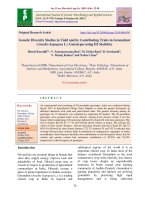
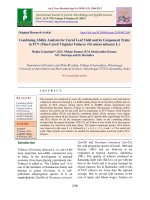
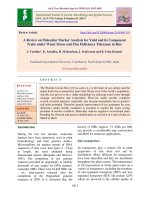
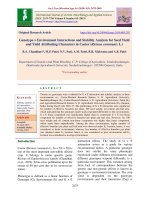
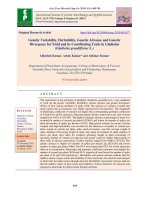
![Genetic parameters for grain yield and nutritional quality traits in foxtail millet [Setaria italica (L.) Beauv.]](https://media.store123doc.com/images/document/2020_01/13/medium_tvq1578927783.jpg)
![Genetic variability studies in F2 segregating populations for yield and its component traits in Okra [Abelmoschu sesculentus (L.)Moench]](https://media.store123doc.com/images/document/2020_01/13/medium_nxs1578931693.jpg)

